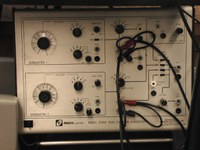Dual Function Generator (Pasco)
Used in the following activities:
Model 9301A. Additional units in the upper year labs.
The unit consists of 2 signal generators, each with frequencies from 1 Hz to 100 kHz with sine, triangular, square, pulse and sawtooth waves available. Each channel is adjustable from 0 to (greater than) 1 volt peak to peak amplitude, and may be phase shifted by 180°. There is a summing amplifier which allows the outputs of the 2 generators to be added. A microphone input and external high level input may be added to the summing amplifier. In addition, generator 2 may be modulated by the output of generator 1 in 4 modes: Amplitude Modulation, Frequency Modulation, Double Side Band, and Gate. Generator 1 may be similarly modulated by any external source.
Specifications
Each generator's frequency dial is accurate to within 5%. The output of each generator is independent of frequency to within 0.1 dB from 20 Hz to 20 kHz.
Frequency Range: 1 Hz - 100 kHz
Output Voltage: (greater than) 1 volt peak-to-peak
Waveforms: sine, triangle, square, sawtooth, 20% duty cycle pulse.
External Inputs: Microphone, High Level to Summing Amplifier, High Level to Modulator for Generator 1
High Level Outputs: Triggers from each generator, Outputs from each generator, microphone preamp, summing amplifier.
Two low quality 8 ohm amplifiers (2 watts at 5% distortion) exist for driving loudspeakers.
Operating Instructions
- Make sure all GAIN and AMPLITUDE controls are off (fully counter clockwise).
- Turn on the unit. The power switch is located in the lower left hand corner.
- Select the modes of operation desired. The signal flow is indicated with arrows on the face plate.
- Connect the "10k" outputs to the desired components; oscilloscope, external amplifier, etc.
- Adjust the generators for the desired frequency. The frequency range switch refers to the frequency, in Hz, of the generator when the dial is fully clockwise.
- Adjust the amplitude of the desired generator.
Original author: Jeremy Bailin and Jaime Espinoza, June 1996
Revised by David Harrison and Jaime Espinoza.





